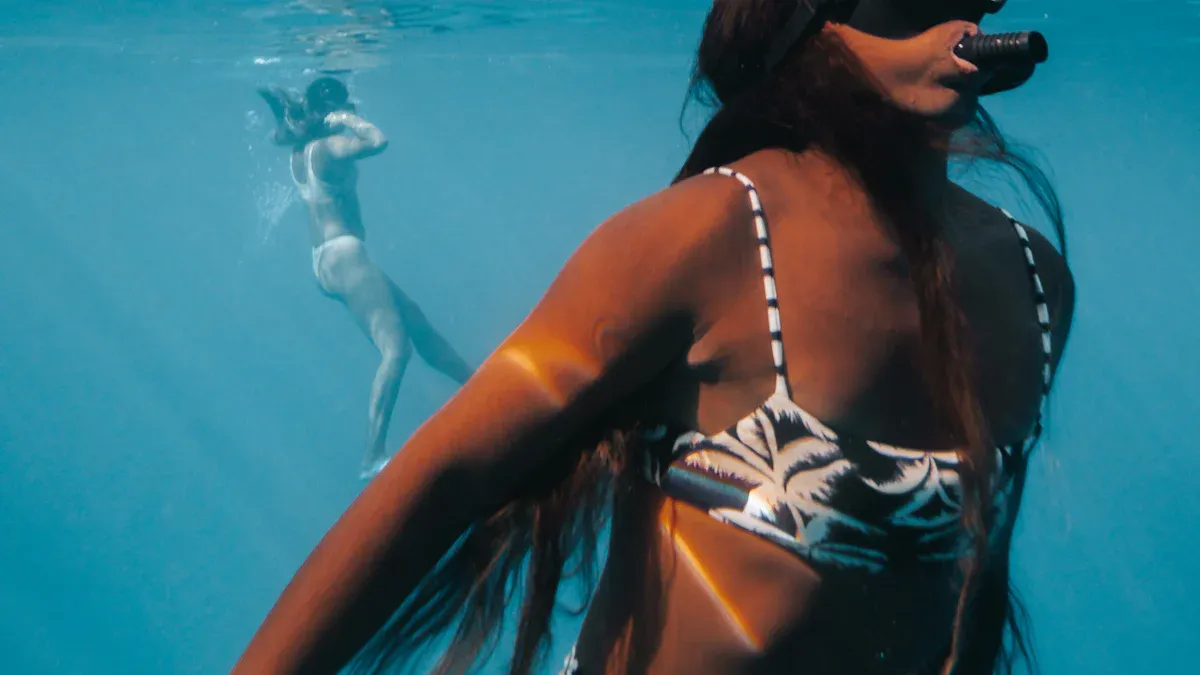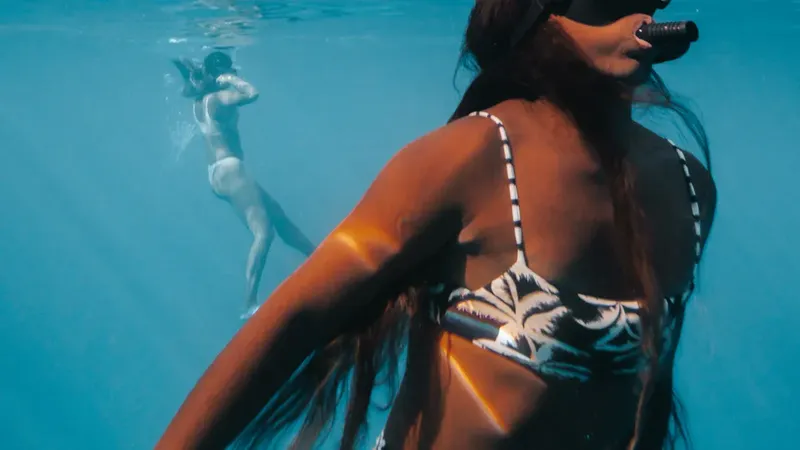
Sustainable swimwear fabrics are revolutionizing the fashion industry by addressing environmental challenges. These materials, such as recycled nylon and polyester, transform waste like fishing nets and plastic bottles into high-quality swimwear. Their production uses less water and fewer harmful chemicals, reducing pollution and conserving resources. This approach supports a circular economy by treating waste as a resource.
The demand for eco-friendly swimwear continues to grow. Consumers now prioritize brands like TideLine Swimwear that use advanced sustainable materials and ethical practices. By choosing these fabrics, you contribute to reducing plastic waste and promoting a greener future.
Key Takeaways
Sustainable swimwear fabrics, like ECONYL and REPREVE, reuse plastic waste. They turn old materials into strong, high-quality swimwear.
Picking eco-friendly swimwear lowers pollution and supports fair work rules. It also helps companies treat workers better.
Choose swimwear made from biodegradable fabrics, like Amni Soul Eco. These break down faster and keep the planet cleaner.
Check for labels like GRS or OEKO-TEX to find brands that care about the Earth and fair practices.
Buying sustainable swimwear helps the planet. It pushes brands to use better materials and create new eco-friendly ideas.
Why Sustainable Swimwear Fabrics Matter
Environmental Benefits
Reduction of plastic waste in oceans and landfills
Sustainable swimwear fabrics play a vital role in reducing plastic waste. Materials like ECONYL® and recycled polyester transform discarded fishing nets, fabric scraps, and plastic bottles into high-quality swimwear. Each swimsuit made from ECONYL® repurposes approximately 4.5 kilos of plastic waste, preventing it from polluting oceans and landfills. As Marine Conservationist John Lee explains, “Recycling nylon reduces the demand for new petroleum-based products and helps clean up our oceans.” By choosing sustainable swimwear, you actively support efforts to clean the environment and reduce reliance on virgin plastics.
Lower carbon footprint compared to traditional fabrics
Traditional swimwear production relies heavily on synthetic materials like nylon and polyester, which are resource-intensive and emit significant greenhouse gases. In contrast, recycled fabrics like ECONYL® and recycled nylon use less water, energy, and harmful chemicals during production. This shift not only conserves resources but also minimizes the environmental impact. Sustainable swimwear fabrics, made entirely from waste materials, support a circular economy while reducing the carbon footprint of the fashion industry.
Social Benefits
Support for ethical manufacturing practices
Sustainable swimwear brands often prioritize ethical manufacturing practices. These include fair wages, safe working conditions, and transparent supply chains. By purchasing from these brands, you contribute to a more just and equitable fashion industry. Ethical labor practices ensure that workers are treated with respect and dignity, making sustainability about more than just the environment.
Promotion of conscious consumerism
The swimwear industry’s connection to natural environments makes sustainability a key focus for consumers. Eco-friendly materials like recycled nylon and ECONYL® align with the growing demand for responsible products. By choosing sustainable swimwear, you encourage brands to adopt greener practices and fulfill their moral responsibility. This shift not only benefits the planet but also empowers you to make informed, impactful choices.
Key Sustainable Swimwear Materials and Their Functions

ECONYL
Made from recycled waste like fishing nets and fabric scraps
ECONYL is a groundbreaking material that transforms waste into high-quality swimwear fabric. The process begins by rescuing discarded materials like fishing nets and fabric scraps. These are sorted, cleaned, and broken down into their original nylon components through a regeneration process. The nylon is then purified and spun into yarn, ready for use in various industries. This innovative approach not only reduces waste but also ensures that ECONYL can be recycled infinitely without losing quality.
Did you know? ECONYL production prevents thousands of tons of waste from polluting the environment every year.
Durable, lightweight, and resistant to chlorine and UV rays
ECONYL offers exceptional functionality for swimwear. Its durability ensures your swimsuit lasts longer, even with frequent use. The fabric resists chlorine and UV rays, maintaining its integrity and protecting your skin from harmful sun exposure.
Benefit | Description |
|---|---|
Ensures long-lasting swimwear, even in harsh conditions. | |
UV Resistance | Shields your skin from harmful sun rays. |
Chlorine Resistance | Maintains fabric quality in swimming pools. |
REPREVE
Created from recycled plastic bottles
REPREVE is another sustainable swimwear material made from post-consumer plastic bottles. The process involves collecting and cleaning the bottles, shredding them into flakes, and melting them into plastic pellets. These pellets are then extruded into filaments and spun into yarn, which is used to create swimwear fabrics. This method reduces plastic waste and lowers carbon emissions compared to traditional polyester production.
Offers stretch, comfort, and moisture-wicking properties
REPREVE fabrics are designed with performance in mind. They wick moisture away from your skin, keeping you dry and comfortable. The material also provides excellent stretch, ensuring a snug yet flexible fit for swimwear.
Property | Description |
|---|---|
Moisture-wicking | Keeps you dry by drawing moisture away from the body. |
Stretch | Offers flexibility and comfort for active use. |
Quick-drying | Dries rapidly, making it ideal for aquatic activities. |
Durability | Ensures long-lasting swimwear products. |
Amni Soul Eco
Biodegradable nylon that decomposes faster in landfills
Amni Soul Eco stands out as the world’s first biodegradable nylon. Unlike traditional synthetic fabrics that take decades to decompose, this material breaks down in just 3-5 years when disposed of in landfills. Laboratory tests confirm its accelerated biodegradability, making it a revolutionary choice for sustainable swimwear.
Maintains elasticity and softness for swimwear
Amni Soul Eco combines sustainability with comfort. Its soft texture feels gentle on your skin, while its elasticity ensures a perfect fit. The fabric is also quick-drying and breathable, enhancing your overall swimwear experience.
Benefit | Description |
|---|---|
Soft touch | Provides a comfortable feel against the skin. |
Elasticity | Ensures a snug and flexible fit. |
Quick drying | Ideal for water-based activities. |
Biodegradability | Decomposes quickly, reducing environmental impact. |
Organic and Natural Materials
Examples include organic cotton, hemp, and bamboo
Organic and natural materials offer eco-friendly alternatives for sustainable swimwear. These materials include:
Organic Cotton: Grown without harmful pesticides or synthetic fertilizers, it supports biodiversity and soil health. It also uses less water than conventional cotton due to improved soil management.
Hemp: A natural fiber with a low environmental impact. It grows quickly, requires minimal water, and enriches the soil.
Bamboo: Known for its rapid growth and ability to thrive without chemicals, bamboo is a renewable and biodegradable option.
Seaweed-based Fabrics: These innovative materials are both sustainable and biodegradable, offering a unique approach to eco-friendly swimwear.
By choosing swimwear made from these materials, you support renewable resources and reduce your environmental footprint. These fabrics are not only sustainable but also gentle on your skin, making them ideal for sensitive users.
Renewable, biodegradable, and gentle on the skin
Natural materials like organic cotton and bamboo decompose easily, leaving no harmful residues. Their cultivation methods prioritize sustainability, ensuring minimal harm to the environment. Hemp, for example, requires no synthetic inputs and improves soil quality. These materials also feel soft and breathable, providing comfort during wear. Opting for swimwear made from organic and natural materials helps you embrace a greener lifestyle while enjoying high-quality products.
Innovative Technologies in Sustainable Fabrics
SILVADUR™ for antimicrobial and temperature-regulating properties
SILVADUR™ technology enhances sustainable swimwear by adding antimicrobial properties. This innovation prevents odor-causing bacteria from growing on the fabric, keeping your swimwear fresh for longer. It also regulates temperature, ensuring comfort in various conditions. By incorporating SILVADUR™, swimwear becomes more functional and durable, reducing the need for frequent replacements. This aligns perfectly with the goals of sustainability.
UV-protective fabrics blocking up to 97.5% of harmful rays
UV-protective fabrics offer another layer of functionality. These materials shield your skin from harmful sun rays, blocking up to 97.5% of UV radiation. They also resist chlorine and saltwater, ensuring durability in harsh environments. Sustainable swimwear made with UV-protective fabrics combines eco-friendliness with practicality, making it a smart choice for outdoor enthusiasts.
Tip: Look for swimwear with UV protection to stay safe under the sun while supporting sustainable practices.
Broader Impact of Sustainable Swimwear

Influence on the Fashion Industry
Encouraging brands to adopt sustainable practices
Sustainable swimwear is reshaping the fashion industry by setting a new standard for environmental responsibility. Many brands now prioritize eco-friendly materials like recycled nylon and ECONYL®. These fabrics transform waste into stylish, durable swimwear, proving that sustainability and performance can coexist. This shift encourages other sectors, such as activewear and casual clothing, to adopt similar practices.
You may notice that brands embracing sustainable swimwear often highlight their commitment to reducing waste and pollution. This transparency builds trust and inspires others in the industry to follow suit. As the demand for eco-conscious products grows, more companies are compelled to adopt sustainable practices to remain competitive.
Driving innovation in fabric technology
The rise of sustainable swimwear has sparked remarkable advancements in fabric technology. Materials like recycled polyester, made from plastic bottles, and biodegradable nylon, such as Amni Soul Eco, showcase how innovation can address environmental challenges. These fabrics not only reduce waste but also offer superior functionality, including UV protection and moisture-wicking properties.
Fun Fact: ECONYL® is made from discarded fishing nets and old carpets, supporting a circular economy while cleaning up the environment.
This trend is driving collaboration between scientists, designers, and manufacturers to create even more sustainable options. The success of these innovations demonstrates that the future of fashion lies in eco-friendly solutions.
Shifting Consumer Behavior
Growing awareness of environmental impact
Consumers like you are becoming increasingly aware of the environmental consequences of traditional swimwear materials. This awareness has transformed sustainable swimwear from a niche market into a mainstream trend. Eco-friendly fabrics, such as recycled nylon and polyester, are gaining popularity for their ability to reduce plastic pollution and conserve resources.
By choosing sustainable swimwear, you contribute to a movement that prioritizes the planet’s health. This shift reflects a broader commitment to reducing waste and protecting marine ecosystems.
Increased demand for transparency and ethical products
Today’s consumers demand more than just stylish swimwear. You likely value transparency and ethical practices when making purchasing decisions. Brands that adopt sustainable materials and fair labor practices gain a competitive edge in the market. On the other hand, companies that fail to embrace sustainability risk losing relevance.
Supporting ethical brands not only helps reduce environmental harm but also promotes fair treatment of workers. This growing demand for accountability is reshaping the swimwear industry, pushing it toward a more responsible and sustainable future.
Sustainable swimwear offers a unique blend of environmental responsibility and high performance. Materials like recycled nylon and ECONYL transform waste into durable, stylish swimwear, reducing plastic pollution and conserving resources. These fabrics also support ethical manufacturing practices, ensuring fair labor conditions. By choosing sustainable options, you help protect marine life, minimize your carbon footprint, and promote a greener fashion industry. Your choices as a consumer drive change, proving that sustainability and style can coexist. Together, we can create a more responsible future for fashion.
Tip: Opt for swimwear made from recycled or biodegradable materials to support eco-conscious practices.
FAQ
What makes sustainable swimwear fabrics eco-friendly?
Sustainable swimwear fabrics use recycled or biodegradable materials like ECONYL or Amni Soul Eco. These materials reduce waste, conserve resources, and minimize environmental harm. By choosing these fabrics, you help lower pollution and support a circular economy.
Are sustainable swimwear fabrics as durable as traditional ones?
Yes, sustainable fabrics like ECONYL and REPREVE offer excellent durability. They resist chlorine, UV rays, and wear, ensuring long-lasting swimwear. These materials combine eco-friendliness with high performance, making them a reliable choice.
How can I identify sustainable swimwear brands?
Look for certifications like GRS (Global Recycled Standard) or OEKO-TEX. Check if the brand uses recycled or biodegradable materials and follows ethical manufacturing practices. Transparent brands often share their sustainability efforts on their websites.
Do sustainable swimwear fabrics feel different from regular ones?
Not at all! Fabrics like REPREVE and Amni Soul Eco feel soft, stretchy, and comfortable. Natural materials like organic cotton and bamboo are gentle on the skin. Sustainable options prioritize both comfort and functionality.
Why should I choose biodegradable swimwear fabrics?
Biodegradable fabrics like Amni Soul Eco decompose faster in landfills, reducing long-term waste. Traditional synthetic fabrics take decades to break down, harming the environment. Choosing biodegradable options helps minimize your ecological footprint.
Tip: Always check the fabric label for details about its sustainability features before purchasing swimwear.
